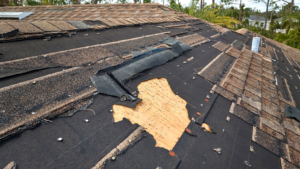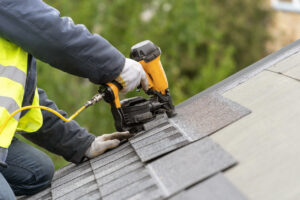In the realm of building integrity, roofs stand as the guardians of protection, shielding structures from the elements. However, this vital component is not impervious to harm. It is crucial for homeowners and businesses in Utah to comprehend the factors that pose the greatest threat to roofs. Delve into this article to uncover the primary culprits behind roof damage and their potential consequences. By equipping oneself with this knowledge, individuals can adopt preventive measures, ensuring the durability and longevity of their roofs.
Common Weather-Related Roof Damage
Frequently, weather-related damages pose significant threats to the integrity and longevity of roofs. When it comes to protecting your home or business from the elements, choosing the right roofing materials is crucial. There are various options available, each with its own advantages and disadvantages. Factors to consider include durability, cost, maintenance requirements, and aesthetic appeal. By selecting the appropriate roofing materials, you can minimize the risk of weather-related roof damage and ensure the long-term health of your roof.
In addition to choosing the right roofing materials, it is important to take preventative measures to maintain a healthy roof. Regular inspections, cleaning debris, and addressing any minor issues promptly can help prevent more extensive roof damage. Proper ventilation and insulation are also essential to prevent moisture buildup, which can lead to mold growth and structural damage.
Understanding roofing insurance coverage options is another key aspect of protecting your roof from weather-related damages. It is important to review your policy carefully and ensure that you have coverage for common weather events such as storms, hail, and wind damage. Additionally, consider adding endorsements or riders to your policy for extra protection.
Impact of Poor Maintenance on Roof Health

Neglecting regular maintenance can have a detrimental impact on the overall health and lifespan of your roof. Here are some key points to consider regarding the impact of poor maintenance on roof health:
1. The importance of regular inspections: Regular inspections allow for the early detection of any potential issues or damage to your roof. By addressing these issues promptly, you can prevent them from escalating into more serious problems that may require expensive repairs or even a full roof replacement.
2. The impact of moisture on roof health: Moisture is one of the biggest threats to the health of your roof. Leaks and trapped moisture can lead to the growth of mold and mildew, which can weaken the structural integrity of the roof and compromise its ability to provide adequate protection. Regular maintenance can help identify and fix any areas where moisture is seeping in.
3. The benefits of professional maintenance: While some homeowners may attempt to perform maintenance tasks themselves, hiring a professional roofing company can provide numerous benefits. Professionals have the expertise, tools, and materials to perform thorough inspections and address any issues effectively. They can also provide valuable advice on how to maintain the roof and prolong its lifespan.
Understanding the Role of Trees and Vegetation
The presence of trees and vegetation can significantly impact the condition and longevity of a roof. One important factor to consider is the effect of shade on roof longevity. While shade can provide relief from the sun’s heat and reduce energy costs, it can also create a moist environment that promotes the growth of algae, moss, and fungi on the roof. These organisms can deteriorate the roof’s materials and lead to leaks and other issues.
To mitigate these problems, it is crucial to regularly trim trees near the roof. This helps prevent leaves, branches, and debris from accumulating on the roof, which can trap moisture and accelerate the deterioration process. Regular tree trimming also reduces the risk of branches falling onto the roof during storms, which can cause significant damage.
Additionally, when choosing roofing materials, it is important to consider their compatibility with trees. Some materials, such as asphalt shingles, are more prone to damage from falling branches or rubbing against tree limbs. Metal or tile roofing options may be more tree-friendly, as they are more resistant to such damage.
The Dangers of Improper Installation and Repair Techniques
Improper installation and repair techniques can lead to significant roof damage and compromised structural integrity of roofs if not addressed promptly and effectively. It is crucial to understand the risks associated with cutting corners or attempting DIY repairs without professional expertise. Here are some reasons why:
1. The importance of professional expertise: Roof installation and repair require specialized knowledge and skills. Professionals have the training and experience to assess the condition of the roof accurately, identify underlying issues, and implement the appropriate solutions. Their expertise ensures that the work is done correctly and up to industry standards, minimizing the risk of future problems.
2. The cost of cutting corners: Taking shortcuts during installation or repair may save money in the short term, but it can lead to costly consequences in the long run. Improper techniques can result in leaks, water damage, and structural issues, requiring expensive repairs or even a full roof replacement. Investing in professional installation and repair can save homeowners from unnecessary expenses down the line.
3. The risks of DIY repairs: While DIY projects can be rewarding, tackling roof damage repairs without proper training and knowledge can be dangerous. Working at heights and handling roofing materials can lead to accidents and injuries. Additionally, DIY repairs may not address the underlying issues effectively, leading to recurring problems or further damage to the roof.
4. Ensuring long-term durability: Proper installation and repair techniques are essential for maintaining the durability and longevity of roofs. Professionals use high-quality materials and follow industry best practices to ensure that the roof can withstand the elements and protect the structure underneath. This attention to detail and expertise is crucial for preserving the integrity of the roof for years to come.
